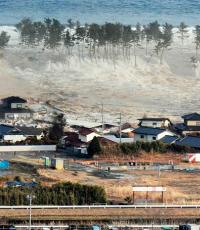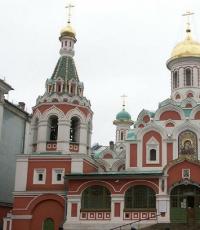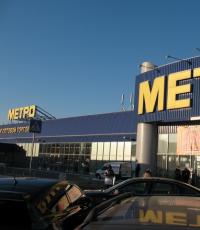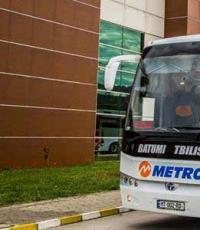How to get to Smolensk. How to get there or how to get to Smolensk, route FROM and TO On a passing train
How to get to Smolensk: by plane, train, bus or car. Current prices, useful tips, all the nuances and details of the route to Smolensk from “Subtleties of Tourism”.
- Tours for the New Year in Russia
- Last minute tours in Russia
So far, Smolensk is not on the list of the most popular Russian tourist destinations, but in vain. Impressive history, good infrastructure, a full range of entertainment, the Dnieper, in the end, seems to be an ideal option for a weekend trip or a short vacation.
Getting to Smolensk from both capitals is not difficult. Let's say right away that there is no direct flight to the city. Smolensk has two airports - South and North - but both of them are now closed.
By train
You can get from the Russian capital to Smolensk comfortably on a direct branded train. The Lastochka will take you to the city on the Dnieper in just over 4 hours. Ticket price (seated seat) - from 452 RUB. Prices on the page are as of November 2018.
If you want to save money, pay attention to the numerous trains passing through. Tickets for them, when compared with the price of travel on a branded train, are almost half the price, although the comfort is noticeably less.
Smolensk is a large railway junction located on the way from Moscow through Minsk to Warsaw. Every day, trains run along this section of the railway to major European cities: Vilnius, Warsaw, Prague and others - a total of about 12 trains every day. To get to Smolensk you can choose any of the passing trains. The train traveling from Novosibirsk to Brest, for example, departs from the capital's Belorussky station at 1:00 and arrives at the central Smolensk station at 7:01.
For those who like day trips, there is a train from Moscow to Brest. It leaves the capital at lunchtime (around 14:00) and arrives at the Smolensk station at 20:00. The minimum fare for a reserved seat carriage is 1000 RUB.
An option for inveterate romantics and hippie youth is the train. And two at once: first from the capital to Vyazma, then from Vyazma to Smolensk. 4 hours - in the first and 3.5 - in the second. Why not.
There is a direct train (087A) from the Northern capital to Smolensk and a passing train heading to Mariupol. Departure from Vitebsky railway station in St. Petersburg. You will have to spend about 16 hours on the road. Ticket price - from 1600 RUB.
By bus
This option is not for everyone, but judging by the number of flights from Moscow to Smolensk, it is quite viable. If you are lucky with the weather and there are no traffic jams on the roads, you will get there faster than by train. And you’ll save money: bus tickets cost a little less than train tickets. Buses depart from Tushinskaya bus station. The journey will take 6 to 7 hours. Price - approximately 800 RUB.
The bus station in Smolensk is located near the railway station. A bus departs from here every day to the capital.
Bus tickets to Smolensk at the best prices
Intercity buses from the city on the Neva to Smolensk depart from Bus Station No. 2. The journey will take you about 15 hours.
By car
Between Moscow and Smolensk approximately 400 km. In a passenger car this route can be covered in an average of 6 hours. You need to take the M-1 highway. Be prepared for traffic jams; unfortunately, they are not uncommon on the way from Moscow to Smolensk.
The Smolensk cemetery in St. Petersburg can probably be called the oldest in the whole city. It appeared approximately simultaneously with the city itself. Moreover, this place attracts with its mystery, mysticism and many legends.
Why Smolenskoye
There is a belief that during construction, workers came from Smolensk. Due to hard work and poor living conditions, they died early. And they were buried on the southern shore of the island along. Since then, the field along it began to be called Smolensk.
However, most likely, this version is just someone’s speculation. The names of the river and cemetery appeared after the construction of a church in this place dedicated to the Smolensk Icon of the Mother of God. The author of this icon was Saint Luke. And Vladimir Monomakh moved it to Smolensk. Hence the corresponding name.
In 1792, the church underwent reconstruction and was re-lit in the name of Archangel Michael. However, the temple has not survived to this day, as it was dismantled in the 19th century.
“Double” Smolensk cemetery
St. Petersburg and the famous cemetery have a common history and almost simultaneous beginnings. So, after the Poltava victory, thanks to which the northern capital exists, there was not a single officially approved cemetery in the city. Wherever they had to, they buried them there. On Vasilievsky Island they were buried along the left bank of the Smolenka River (formerly the Chernaya River). In 1710, a military chancellery was built here, and the cemetery became a burial place for prisoners who died in the St. Petersburg prison. Rumor has it that the dead criminals were buried in shackles.
The name “Smolensk Cemetery” refers to two independent cemeteries located nearby - Orthodox and Lutheran (German). The Orthodox is considered the oldest.

This cemetery became the official burial place in 1738 by decree of the Synod. The German cemetery was opened later - in 1747.
The cemetery was put in order and landscaped. Since there was no chapel of its own, in 1755 a church was erected in honor of the Smolensk Icon of the Mother of God. Since then, parishioners, city residents, and cadets have been buried here. In 1807, the remains of the Knights of Malta were buried. In 1831, a burial site for people who died of cholera was fenced off here.
By the mid-19th century, the Smolensk cemetery in St. Petersburg was considered the largest in the city. In 1860, the number of those buried was 350 thousand. Today the territory of the churchyard is about 50 hectares.
Flood

At the end of 1824, a flood hit the Smolensk cemetery. All the fences were demolished, the crosses were washed away, the burial places themselves were covered with earth so that it was almost impossible to find them. After the flood, many were unable to find the graves of their loved ones. The flood destroyed the entire archive located in the church; only the parish books, which the priests kept at home, were preserved. was destroyed almost to the ground. As a result, it had to be demolished, since the building could no longer be restored. During the flood, three old women even drowned because they were unable to escape.
In short, the entire cemetery was thrown into complete disarray and suffered enormous losses. A lot of time and effort was spent removing and restoring everything. However, many burials remained unfound. For example, the burial of the Knights of Malta.
The Legend of the Forty Priests
The Smolensk cemetery in St. Petersburg is usually crowded. Not only relatives come here to honor the memory of the deceased, but also those who simply want to take a walk and look at the graves of famous people, as well as those who want to plunge into the atmosphere of secrets and mysticism. In the old historical part of the cemetery, which is very neglected, according to legend, you can meet ghosts. Many legends are associated with this place. And the most terrible and sinister is the legend of the 40 martyrs in the name of faith. Many scientists and historians believe that this is not just a legend, but an event that actually took place.
In the 20s of the last century, the authorities arrested forty priests belonging to the Leningrad diocese. Those arrested were brought to the Smolensk cemetery. They were lined up along the dug grave and given a choice: either life in exchange for renunciation of God, or death. None of the priests renounced God. Then they were all buried alive. According to eyewitnesses, for three days the groans of the martyrs were heard from underground, and then the grave was illuminated by a Divine ray, and it became quiet.
Despite the fact that almost a century has passed since the tragedy, people come to the grave to honor the memory of the forty martyrs. There are always candles burning and flowers on the grave.
Blessed Xenia of Petersburg

The Smolensk cemetery is also famous for the intercessor and guardian of St. Petersburg, famous throughout the city. And many legends are also associated with the name of this patroness.
So, according to one of them, a young girl Ksenia, having buried her husband, distributed everything she had to the poor, put on the deceased’s coat and became insane. Both in the heat and in the cold, she wandered through the city streets and said all sorts of crazy things to passers-by. But it soon became clear that everything Ksenia said had a deeper meaning. She had the gift of clairvoyance.
After Ksenia died, people began to come to the madwoman’s grave at the Smolensk cemetery. And soon a chapel was built in her honor. This church did not close even during Soviet times. People believe that if you walk around the church three times, while thinking about your innermost thoughts, then the Blessed Xenia will fulfill your wish. This is probably why you can often find suffering lovers there.
Not only legends

The Smolensk cemetery in St. Petersburg is famous not only for its secrets. Many famous St. Petersburg residents are buried on the territory of the cemetery.
Luminaries of science such as Zablotsky, Viskovatov, Beketov, writers Sollogub, Charskaya, Emin, artists Makovsky, Shebuev, Jordan and Shchukin.
On the central alley of the cemetery you can see the graves of Mozhaisky - the man who designed the world's first airplane, the creator of armadillos - Popov, the famous traveler Semenov-Tien-Shansky, the navigator Valkitsky, the commander of the Panther submarine Bakhtin, as well as Dostoevsky's brother and nephews.
Not far from the grave of forty priests is the Blokovskaya path. Alexander Blok was buried at this place in 1921. The poet’s grave had long been moved to the Volkovskoye cemetery, but the “original” place was not forgotten. There is a memorial stone there, and flowers from fans.
In addition to the graves of famous figures, there are beautiful and unusual monuments at the Smolensk cemetery. For example, a monument dedicated to the ranks of the Russian police, which has been preserved since pre-revolutionary times. This monument is constantly looked after by traffic police officers.
Cemetery today
In the post-revolutionary years, the cemetery was closed due to lack of space. And part of the land with burials was given for the construction of... a kindergarten.

In order to preserve at least the monuments and tombstones of famous figures, they were moved to the Alexander Nevsky Lavra. Today, the Orthodox part of the cemetery has been restored: the tombstones and chapel have been restored, the alleys have been improved, and a special archive of all burials is being maintained. They no longer bury people in the cemetery (except in special cases).
The German part is in great disrepair, and there are even rumors of impending demolition. However, there have been no changes so far, and people still come here to look at the preserved monuments of the 18th century.
So, if you decide to visit the Smolensk cemetery, how to get there? The nearest metro station is Vasileostrovskaya. There is a stop near the metro exit. Take minibus No. K-249 and drive fifteen minutes to Kamskaya Street. Along it, without turning anywhere, you go straight, and ahead is the Smolensk cemetery. Address: Kamskaya street, 3.
Search and create public transport routes that are optimal for you FROM your location to the desired street or house, as well as car, bicycle and walking routes for walking.
Choose transport:
Public transport By car Bicycle On foot
Show route on map
Route on the city map.
Are you asking where you can get or how to get to a certain street or house in Smolensk? The answer is very simple, find your optimal route around the city using the trip planner on our website. Our service will find for you up to 3 options for travel around the city of Smolensk FROM your address to your destination. On the map with routes, click the more details button (the start icon) and go to a detailed description of travel options. For all routes, travel time will be shown taking into account traffic jams, numbers of buses, minibuses and other public transport.
Popular routes:
- FROM: Smolensk, Belyaeva street, 1 - TO: Smolensk, Dzerzhinsky street;
- FROM: Smolensk, Malo-Krasnoflotskaya street, 14 - TO: Smolensk, Kirova street, 27B;
- FROM: Smolensk, Matrosova street, 18 - TO: Smolensk, m raskovoy street 11 a;
- FROM: Smolensk, Gagarin Avenue 23 - TO: Smolensk, Marina Raskova Street, 11A;
- FROM: Smolensk, Krupskoy 61 v - TO: Smolensk, Marshal Sokolovsky Street, 7B;
Users of our site often ask, for example: “How to get from the bus station to the hospital?” and so on. We decided to make it easier for everyone to find the optimal route.
Driving along a pre-designed route is a way to eliminate problems that may arise in unfamiliar areas and overcome the desired section of the road as quickly as possible. Don’t miss out on details; check the map in advance for directions on the road and turns.
Using the trip planning service, you just need to enter the beginning and end of the route, then click the “Show route on the map” button and you will receive several route options. Choose the most suitable one and start moving. Four modes of route planning are possible - by city public transport (including minibuses), by car, by bicycle or on foot.
Smolensk is located on the Dnieper River, and the distance from Smolensk to Moscow is about 400 kilometers.
First of all, I would like to tell you how you can get from Moscow to Smolensk.
Moscow-Smolensk
There is no airport in the city, so air transport is immediately rejected.
By train
One of the most popular options is rail travel.
At high speed train Swallow You can get from Moscow to Smolensk in 4 hours 37 minutes. The train leaves the Belorussky railway station in Moscow and arrives at the Smolensk railway station. The Swallow train is modern and quite comfortable, so the ticket price is relatively high - it is 1,160 rubles (seats, of course). Lastochka is also the fastest way to get from Moscow to Smolensk; other trains take about 6 hours.
For those who would like to save money, there is a cheaper option - you can go, for example, by train Novosibirsk - Brest, which makes a stop in both Moscow and Smolensk. The journey will be at night, in Moscow the train stops at 1 am, and arrives in Smolensk at 7:01 (travel time will be 6 hours). A reserved seat ticket costs only 712 rubles, thus being the cheapest train travel option. A place in a compartment will cost one and a half thousand rubles.
For those who prefer day trips, we can recommend the train Moscow - Brest, which leaves the capital at 14:09 and arrives in Smolensk at 20:00. Travel time is almost 6 hours. For a place in a reserved seat you will have to pay 794 rubles, and in a compartment - one and a half thousand.
By bus
Another relatively inexpensive way to get to Smolensk. Buses leave from the Tushinskaya bus station to Pskov. The bus leaves Moscow at 20:00 and stops in Smolensk at 2:30, so the travel time is six and a half hours. Such a trip costs 700 rubles.
By car
As mentioned above, the distance from Moscow to Smolensk is about 400 kilometers. By car, this distance can be covered in 4 - 6 hours (depending on traffic jams and, of course, speed).
For those who want to save money, there are travel companion services that allow you, for a small fee (about 500 rubles on average), to sit with a driver who is traveling along this route. So, the driver will save on gasoline, and you will save on the ticket. The downside is that you will have to travel in a car with an unfamiliar (and maybe not the most pleasant) person.
St. Petersburg - Smolensk
Getting to Smolensk from the Northern capital is more difficult than from Moscow, since the distance between these cities is significantly greater (about 750 kilometers).
However, this can be done using the same types of transport as from Moscow - by train, bus and car.
By train
One of the most popular options is train St. Petersburg - Smolensk.
It leaves St. Petersburg at 20:45, and arrives in Smolensk at 12:51 the next day. Travel time is 16 hours. A seat in a reserved seat will cost you 1,030 rubles, and in a compartment - 2,730 rubles.
By bus
A cheaper option is the bus. Transportation is carried out by a variety of companies, and on the website you can find out their name and the type of bus on which you will be transported.
For example, you can take the bus at 8:30 at bus station No. 2 (Obvodny Canal embankment), and at 23:00 on the same day you will find yourself in Smolensk. Travel time will be 14 and a half hours.
By car
Those 750 kilometers that separate St. Petersburg from Smolensk can be covered in 8 hours or more. Services for finding travel companions offer prices starting from 900 rubles per person.
City transport in Smolensk
And finally, let's start describing transport within the city itself. If you have already reached Smolensk, then you are faced with a new question - how to move around the city?
First of all, I note that, of course, there is no metro in Smolensk. But there are buses, trolleybuses, trams, minibuses and, of course, taxis.
Trams
There are five tram routes in the city. I quote them below:
Route No. 1. Lamp Factory - Gagarin's Ring
Route No. 2. st. P. Alekseeva - st. Bagration
Route No. 3. Sitniki - Gagarin Ring
Route No. 4. Roslavl ring - railway station
Route No. 7. st. P. Alekseeva - railway station
Trolleybuses
This type of transport in general is not very popular in Smolensk, so it is limited to just a few routes.

Route No. 1. Printing plant - Sharm LLC
Route No. 2. P. Alekseev St. - NPO "Arkada"
Buses
There are already significantly more bus routes (so I won’t list them here). In general, buses connect almost all districts and microdistricts of Smolensk.

The fare for any municipal transport is the same and amounts to 14 rubles per trip..
Taxi
There are more than 10 different companies providing taxi services in Smolensk. Their prices differ slightly.
Electric trains
From the Smolensk railway station you can take a train to the nearest suburbs and neighboring cities, where there is also something to see (for example, to Vyazma, where you can admire various churches and monasteries). The distance to Vyazma is 175 kilometers, so keep in mind that the train takes several hours.





